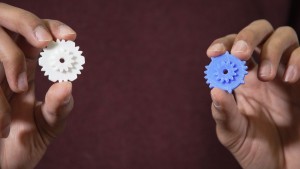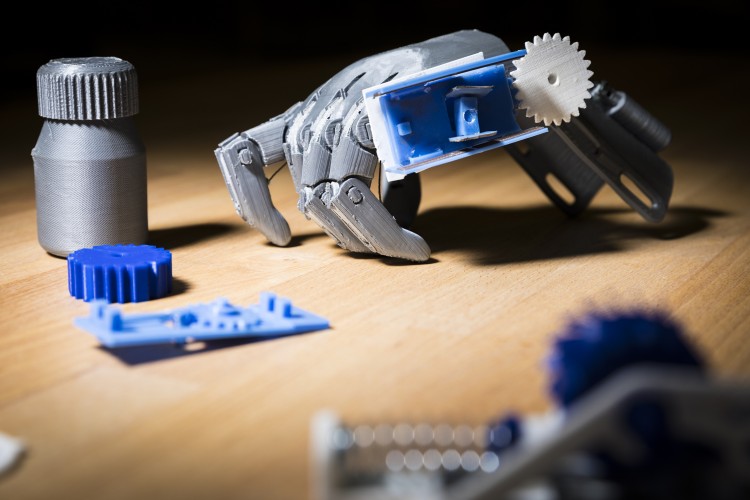Researchers at the University of Washington have developed smart 3D printed items that can track and store information about their own use, without the need for any electronics. These items, such as pill bottles or prosthetics, can gather valuable information using a method called backscatter, which involves reflecting signals that have been transmitted with an antenna.
The research has been documented in a paper entitled “Wireless Analytics for 3D Printed Objects.”
“We’re interested in making accessible assistive technology with 3D printing, but we have no easy way to know how people are using it,” said co-author Jennifer Mankoff, a professor in the UW’s Paul G. Allen School of Computer Science & Engineering. “Could we come up with a circuitless solution that could be printed on consumer-grade, off-the-shelf printers and allow the device itself to collect information? That’s what we showed was possible in this paper.”
The same researchers have used backscatter has been used to transmit signals between 3D printed objects without electronics before, allowing them to connect to Wi-Fi.
“Using plastic for these applications means you don’t have to worry about batteries running out or your device getting wet. That can transform the way we think of computing,” said senior author Shyam Gollakota, an associate professor in the Allen School. “But if we really want to transform 3D printed objects into smart objects, we need mechanisms to monitor and store data.”

Back row (left to right): Vikram Iyer, Jennifer Mankoff, Ian Culhane; Front row: Shyam Gollakota, Justin Chan.
In the previous study, the system tracked movement in one direction, which was useful for things like monitoring the level of laundry detergent in a bottle or measuring wind or water speed. For this study, however, they needed to be able to monitor bidirectional motion, like the opening and closing of a pill bottle.
“Last time, we had a gear that turned in one direction. As liquid flowed through the gear, it would push a switch down to contact the antenna,” said lead author Vikram Iyer, a doctoral student in the UW Department of Electrical & Computer Engineering. “This time we have two antennas, one on top and one on bottom, that can be contacted by a switch attached to a gear. So opening a pill bottle cap moves the gear in one direction, which pushes the switch to contact one of the two antennas. And then closing the pill bottle cap turns the gear in the opposite direction, and the switch hits the other antenna.”
The antennas are identical, so the team needed to figure out how to tell which in which direction the cap was moving, whether it was opening or closing.
“The gear’s teeth have a specific sequencing that encodes a message. It’s like Morse code,” said co-author Justin Chan, a doctoral student in the Allen School. “So when you turn the cap in one direction, you see the message going forward. But when you turn the cap in the other direction, you get a reverse message.”
 This method can also be used to determine how people are using prosthetic devices. To demonstrate this, the team 3D printed an e-NABLE hand with a prototype of their bidirectional sensor, which monitors the opening and closing of the hand by determining the angle of the wrist. The team also wanted to 3D print an item that could store information while out of Wi-Fi range. They went with an insulin pen that could monitor its use and signal when it was getting low.
This method can also be used to determine how people are using prosthetic devices. To demonstrate this, the team 3D printed an e-NABLE hand with a prototype of their bidirectional sensor, which monitors the opening and closing of the hand by determining the angle of the wrist. The team also wanted to 3D print an item that could store information while out of Wi-Fi range. They went with an insulin pen that could monitor its use and signal when it was getting low.
“You can still take insulin even if you don’t have a Wi-Fi connection,” Gollakota said. “So we needed a mechanism that stores how many times you used it. Once you’re back in the range, you can upload that stored data into the cloud.”
This process requires a mechanical motion, like the pressing of a button. The information is stored by rolling up a spring inside a ratchet that can only move in one direction. Each time the button is pushed, the spring gets tighter. It can’t unwind until the ratchet is released, at which point the spring unwinds and moves a gear that triggers a switch that repeatedly contacts an antenna as the gear turns. The contacts are counted to determine how many times the button was pushed.
The next step will be shrinking down the 3D printed prototypes so that they can be embedded in things like pill bottles and insulin pens, according to Mankoff.
“This system will give us a higher-fidelity picture of what is going on,” she said. “For example, right now we don’t have a way of tracking if and how people are using e-NABLE hands. Ultimately what I’d like to do with these data is predict whether or not people are going to abandon a device based on how they’re using it.”
Discuss this and other 3D printing topics at 3DPrintBoard.com or share your thoughts below.
[Source/Images: University of Washington]
Subscribe to Our Email Newsletter
Stay up-to-date on all the latest news from the 3D printing industry and receive information and offers from third party vendors.
You May Also Like
Gorilla Sports GE’s First 3D Printed Titanium Cast
How do you help a gorilla with a broken arm? Sounds like the start of a bad joke a zookeeper might tell, but it’s an actual dilemma recently faced by...
Nylon 3D Printed Parts Made More Functional with Coatings & Colors
Parts 3D printed from polyamide (PA, Nylon) 12 using powder bed fusion (PBF) are a mainstay in the additive manufacturing (AM) industry. While post-finishing processes have improved the porosity of...
$25M to Back Sintavia’s Largest Expansion of Metal 3D Printing Capacity Since 2019
Sintavia, the digital manufacturing company specializing in mission-critical parts for strategic sectors, announced a $25 million investment to increase its production capacity, the largest expansion to its operations since 2019....
Velo3D Initiates Public Offering in a Bid to Strengthen Financial Foundations and Drive Future Growth
Velo3D (NYSE: VLD) has been among a number of publicly traded 3D printing firms that have attempted to weather the current macroeconomic climate. After posting a challenging financial report for 2023,...
































